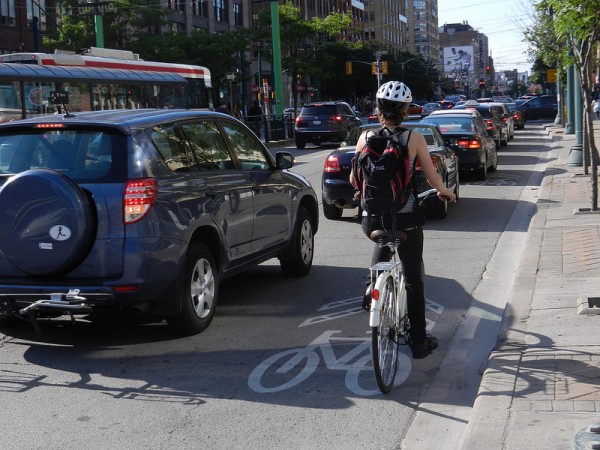
This post by Daniel Arancibia is part of Spacing‘s partnership with the Toronto Cycling Think and Do Tank at the University of Toronto. Find out more about the think tank, and the series, here.
Years ago, stuck in traffic on Spadina Ave, I looked around at what appeared to be an infinite number of cars in all directions and thought to myself: “I hate being stuck in here, but how could we possibly move this many people in any other way?” I was letting my eyes do all the thinking, and sometimes our eyes deceive us.
The definition of gridlock on our streets may as well be “running out of space”. Space is often the limiting factor in the equation of modern urban mobility. 20th century planners, in response to space constraints, sought to build sprawling cities with ever larger streets (and ever increasing costs) to accommodate millions and millions of automobiles. The general idea was that space for cars would be so plentiful and densities so low that traffic would never grind to a halt as a result of congestion.
In Toronto, where most arterial streets were widened to accommodate more automobiles during the post-war period, we are running out of space again. This time around, we cannot expand the roads without destroying the very destinations roads are supposed to take us to. The good news is this is only a major problem until you consider the whole point of transportation infrastructure is to move people (and goods), and not to move cars; people take up a lot less space than cars.
While I was stuck on Spadina I wasn’t counting the cars, much less the pedestrians, cyclists, and transit users. My judgement then was a result of unconsciously equating material mass to volumes of people. It never crossed my mind that I wasn’t helping the traffic by taking 30m2 all for myself and a passenger!
Now I know that a single rush hour streetcar on Spadina Avenue moves more people than all the surrounding cars on the same block combined. I have also learned that if more of us used bicycles when making neighbourhood trips (distances less than 5km), there would be more space and less congestion for everybody (as well as cleaner air, fewer accidents, etc). Trips wouldn’t necessarily take longer: bicycles can, and often do, outperform cars and transit in tight urban settings.
To better visualise the relative spatial efficiency of automobile and bicycle traffic, I set out to capture a photograph of the Becel Heart and Stroke Ride for the Heart as riders took over the Gardiner Expressway – an elevated highway in downtown Toronto. I managed to obtain a picture where you can see approximately the same number of people on each deck of the structure – some in cars, some in bikes. In the elevated portion of the highway I counted 72 people in total (67 in bicycles and 5 pedestrians). In the lower portion (Lakeshore Blvd) I counted 60 cars carrying approximately 72 people. I used binoculars and peaked into the first 20 cars to calculate a ratio of people per vehicle of 1.2 (which is slightly more generous than the number Metrolinx uses, of 1.15 people per car).
The picture speaks for itself. Not only could you fit at least 4 times as many cyclists in the upper deck without affecting traffic flow, people on bicycles were moving faster than those in the cars below!
The interesting thing is that you could probably fit all the cyclists pictured on the upper deck into the space of a single traffic lane without much difficulty. Allocating paths and lanes for cyclists throughout the city would in effect increase the capacity of roads rather than decrease it. This would be especially true if these lanes encourage people who are currently ‘interested but concerned’ to use their bicycles for transportation.
In a city that has become globally notorious for its congestion, we need to consider allocating more road space to those who use it most efficiently.
Daniel Arancibia is a research assistant with the Toronto Cycling Think & Do Tank
The post Cycling Think & Do Tank: perceptions of space and gridlock appeared first on Spacing National.
